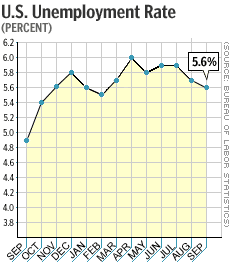NEW YORK (CNN/Money) - The U.S. unemployment rate dipped in September even though businesses cut thousands of jobs from their payrolls, the government said Friday, as the labor market continued its stop-and-go recovery.
The Labor Department said unemployment fell to 5.6 percent in September from 5.7 percent in August. But employers cut 43,000 jobs from payrolls after adding an upwardly revised 107,000 jobs in August.

Economists, on average, expected unemployment of 5.9 percent and employers to add 6,000 jobs, according to Briefing.com. The report hurt stocks, but probably will keep the Federal Reserve on hold for now.
"This will be a positive [contribution] to consumer confidence," said Anthony Chan, chief economist at Banc One Investment Advisors. "It's too early to jump up and say things are completely turned around, but for the moment, it buys us more time."
The data initially helped U.S. stock prices move higher, but those gains soon disappeared, and the Dow Jones industrial average closed at its lowest in five years. Treasury bond prices were mixed.
While it seems contradictory for job cuts to increase even as the unemployment rate falls, the data are based on separate surveys -- the unemployment rate is based on a survey of households, while the payrolls data are based on a survey of businesses.
The Labor Department described levels of unemployment and payrolls as "essentially unchanged," and the unemployment rate has bounced around between 5.6 percent and 6.0 percent since last November.
U.S. businesses cut nearly 1.8 million jobs from payrolls during a recession that began in March 2001. Unemployment is a lagging economic indicator, meaning it usually will continue to grow even as the economy recovers, since businesses are reluctant to hire new workers until they're absolutely sure the economy is recovering.
| 
| |

| 
| 
|

|
 CNNfn's Kathleen Hays takes a closer look at the mixed signals in the jobs report. CNNfn's Kathleen Hays takes a closer look at the mixed signals in the jobs report.
|
|
Play video
(QuickTime, Real or Windows Media)
|
| 
|

|
|
The recent slow pace of job growth has led many economists to label this recovery from the March 2001 recession a "jobless" recovery, similar to the one that followed the 1990-91 recession, when the unemployment rate kept rising for more than a year after the recession was over.
Though a total of 64,000 new jobs have been added between July and September, many economists think at least 125,000 new jobs need to be added every month in order to keep the unemployment rate down.
In Friday's report, the number of unemployed workers fell slightly to 8.09 million from 8.14 million in August. But the civilian labor force -- the number of people either working or out of work and actively seeking a job -- rose by 661,000.
"More people are coming in [to the labor force], and we're not creating enough jobs to put much downward pressure on the unemployment rate," Jared Bernstein, labor economist at the Economic Policy Institute, told CNNfn's CNNmoney Morning program. "But this is better news than expected."
| Related stories
|

|
|
|
|
Though some economists had grumbled before the report that the Federal Reserve might step in with an emergency interest-rate cut if non-farm payrolls fell significantly in September, the slight dip in the unemployment rate seemed likely to keep the Fed on hold for the time being.
"This [report] makes no sense, but it gets the Fed off the hook; [there will be] no intermeeting ease," Ian Shepherdson, chief U.S. economist at High Frequency Economics Ltd., said in a note.
To keep consumers spending by lowering the cost of borrowing, the Fed cut its target for short-term interest rates 11 times in 2001. It's left rates alone so far this year as it tries to judge the economy's course.
The Fed will have another unemployment report to study before its next policy meeting, scheduled for Nov. 6.
In Friday's report, most of the contraction in non-farm payrolls was concentrated in manufacturing, which lost 35,000 jobs, and retail trade, which lost 16,000 jobs. The service sector, the nation's biggest employer, added 28,000 jobs, while government payrolls rose by 4,000.
The amount of hours worked per week averaged 34.3, compared with 34.1 in August. Overtime hours worked fell 0.1 percent after rising 0.2 percent in August.
Average hourly earnings rose 5 cents to $14.87.

|

